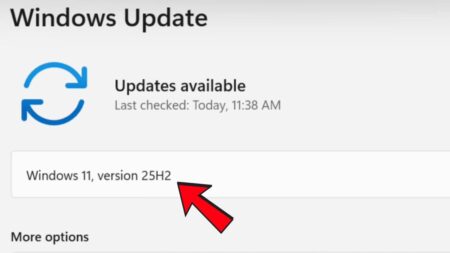Microsoft added various options within the Windows 11 and Windows 10 Operating system using which users can manage different components of the device. However, there are some settings that you can manage only from BIOS.
BIOS full form reads Basic Input Output System, the software comes preinstalled in the device motherboard and manages everything from Boot order, PTT Security, and even more.
Every computer or laptop manufacturer loads BIOS with recommended settings for the proper functioning of the device based on configuration. However, it is possible that sometimes you need to access BIOS and there the various reasons for doing so.
How to Get Into BIOS Windows 11 and Windows 10
In case, you’re trying to enter BIOS for the first time, then it’s highly possible that you don’t know to do that. All you have to do is press a specific key at the right time. Even in the latest Windows devices that come with UEFI BIOS, the process is much easier.
Enter BIOS Windows 11 via the Settings app
You can use the Settings app in Windows 11 to access BIOS. One of the easiest methods to enter BIOS, but you can use this method only if you’re able to log in to your device.
Launch ‘Settings app’ in Windows 11 by pressing WIN + I key combination
Switch to the System tab on the left, and then on the right side scroll down to the Recovery option.
![How to Get Into BIOS in Windows 11/10 PC 2024 [All Ways] 1 enter bios windows 11 via settings app](https://geekermag.com/wp-content/uploads/2023/08/advanced-startup.jpg)
On the Recovery Settings page under Recovery options, locate the ‘Advanced setup‘ option and click on the ‘Restart now‘ button. Doing this will restart your computer.
Enter BIOS Windows 10 via the Settings app
Like Windows 11, you can also enter BIOS in Windows 10 via the Settings app. Here’s how you can do that:
Launch the Settings app in Windows 10 and then select Update & Security > Recovery.
![How to Get Into BIOS in Windows 11/10 PC 2024 [All Ways] 2 enter bios windows 10 via settings app](https://geekermag.com/wp-content/uploads/2023/08/advanced-startup-windows-10.jpg)
On the right side, head over to the Advanced Startup section and then click on the ‘Restart now‘ button. Doing this will reboot your device.
Once you enter the ‘Advanced startup‘ screen, you will see the following screen. The steps discussed below are common for both Windows 11 and Windows 10 PC.
![How to Get Into BIOS in Windows 11/10 PC 2024 [All Ways] 3 Advanced options in windows 10](https://geekermag.com/wp-content/uploads/2021/06/UEFI-Firmware-Settings.png)
Next, you will see Choose an option screen, here select ‘Troubleshoot‘> ‘Advanced options‘ > ‘UEFI Firmware settings.’ At last, click on the ‘Restart‘ button.
![How to Get Into BIOS in Windows 11/10 PC 2024 [All Ways] 4 UEFI Firmware settings](https://geekermag.com/wp-content/uploads/2021/06/restart.png)
Your device will boot straight into your UEFI BIOS of Windows 11 and Windows 10.
![How to Get Into BIOS in Windows 11/10 PC 2024 [All Ways] 5 Dell bios settings](https://geekermag.com/wp-content/uploads/2021/06/dell-bios.png)
Apart from that, if you’re unable to log in to Windows 11 and Windows 10, then you can still reach UEFI Firmware settings. For that, here’s what you need to do:
How to Enter BIOS Windows 11/10 from Startup
Use the Hard Shut Down Method
Start your device, as Windows attempts to load (spinning dots) or (round circles), and press and hold Power Button for 5-10 seconds to perform a Hard shutdown. Repeat this 2-3 times, until you reach the Recovery screen.
Next, click on See Advanced Repair options > ‘Advanced options‘ > ‘Troubleshoot‘ > ‘Advanced options‘ > ‘UEFI Firmware settings.’ At last, click on the ‘Restart‘ button.
Your device will boot straight into your UEFI BIOS of Windows 11 and Windows 10.
Using Keyboard Combination
Each computer manufacturer has assigned a different key to get into BIOS no matter what OS you have installed on your PC. It’s a traditional method that we’ve been using for a long time. What we need to do is to restart the device and when the system tries to load Windows 11 and Windows 10, need to press the BIOS key at the right moment.
If you missed that moment, the Windows will load up and you have to perform it again.
![How to Get Into BIOS in Windows 11/10 PC 2024 [All Ways] 6 enter bios in dell windows 10 pc](https://geekermag.com/wp-content/uploads/2021/06/enter-bios-in-dell-windows-10-pc.png)
Most Windows computers show a screen for a few seconds with the option to enter BIOS with a key that you need to press. Some of the common keys that enter the BIOS F1, F2, F10, Delete, and Esc. Apart from that, key combo like Ctrl + Alt + Delete or Ctrl + Alt + Esc is also helpful in some cases.
To save you time, we decided to cover keys to enter BIOS in various Windows computer manufacturers. You can check your device manufacturer and try the keys:
Enter BIOS Dell
In the latest Dell computer, press F2 when the Dell logo appears on the screen. Alternatively, you can also try F1, F3, F12, and Delete. If F2 is not working.
In earlier models, try these key combos Fn + F1, Fn + Delete, and CTRL + Alt + Enter.
Enter BIOS Lenovo
You can press the F1 or F2 key to enter BIOS in Lenovo devices. Apart from that, older devices try Fn + F1, CTRL + ALT + Insert Key, and CTRL + ALT + F3.
Enter BIOS HP
The most common keys to enter HP BIOS settings are ESC and F10. Apart from that, some devices boot in BIOS with these keys F1, F2, F6, or F11.
In HP tablets F10 and F12 keys are useful.
Enter BIOS Acer
In Acer devices, you can press F2 and the Delete key to enter Acer hardware, Setup, or BIOS. In older devices, F1 and CTRL + ALT + Esc work.
In case your device supports Acer BIOS, then you can reset BIOS settings by pressing and holding the F10 key.
Enter BIOS ASUS
In an Asus device, F2 is the key you need to press to enter ASUS BIOS settings. Alternatively, you can Delete, Insert, and F10 keys.
Enter BIOS MSI
If your computer uses an MSI motherboard, then Delete and F2 (in some models) to enter MSI BIOS settings.
You might also see a message “Press Del to enter setup” before Windows loads up. At that time, pressing the Delete key will enter BIOS settings.
Enter BIOS Sony
If you own a Sony VAIO laptop, then use either F2 or F3 to enter Sony BIOS settings. In some models, F1 works too if F2 and F3 not working.
In case, your device comes with the VAIO Assist key, then press and hold the key until your laptop turns ON.
Enter BIOS Toshiba
The majority of the Toshiba devices enter BIOS settings if you press the F2 key. Apart from that, some models open the gates by pressing F1, F12, and Esc.
These are some of the major Windows Computer manufacturers and the keys to enter BIOS settings for these devices. In case, you own a device from the manufacturer listed above, then you can search for its BIOS keys on the internet. If you are unable to find it, then feel free to ask us.
So the question is did you manage to Enter BIOS in Windows 11 and Windows 10 PC? Which Windows PC you’re using and what BIOS key helps you in achieving the same? Let us know in the comments.
Frequently Asked Questions (Faqs)
Can I harm my computer by changing BIOS/UEFI settings?
Yes, incorrect changes in BIOS/UEFI settings can potentially cause hardware or software issues. It’s essential to be cautious and only modify settings if you’re familiar with their implications. Always document your changes and be prepared to reset to default settings if needed.
Why should I access BIOS/UEFI settings?
Common reasons for accessing BIOS/UEFI settings include changing boot priorities (e.g., booting from a USB drive), overclocking hardware, enabling or disabling virtualization, updating firmware, troubleshooting hardware issues, and configuring security settings like Secure Boot.
What if I can’t access BIOS/UEFI settings?
If you’re having trouble accessing the BIOS/UEFI settings using the designated key, try restarting your computer and pressing the key multiple times during startup. If that doesn’t work, consult your computer’s manual or the manufacturer’s website for specific instructions.





